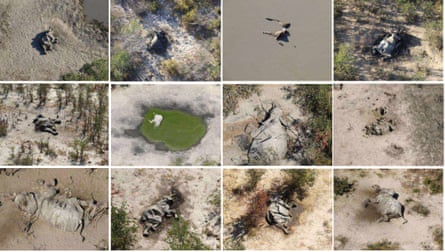The mystery of the elephant deaths was finally solved after years of investigation. However, the danger is now expanding.
T
The initial elephant that passed away was a male, eight years of age. It was discovered on August 24, 2020, on the southern edge of the Panda Masuie forest reserve in Zimbabwe. The elephant was found collapsed on its side, resembling a grey tent in the reddish soil.
Dr. Chris Foggin, a wildlife veterinarian at the Victoria Falls Wildlife Trust, suspected anthrax as the potential cause of death when he examined the animal. Due to it being a common threat during that time of year, he took precaution while collecting organ samples and disposed of the carcass by burning it afterwards.
However, in the following 48 hours, an additional ten deceased elephants were discovered. These elephants were mostly young and all were found within a short distance of each other. Typically, anthrax only results in isolated deaths. The total count of carcasses increased to 35, causing worry that more may still be undiscovered. Just two months prior, 350 elephants had suddenly died in the Okavango delta in Botswana, leading to speculation about the cause of these tragedies.
The findings from Foggin’s initial experiments have been released after three years, finally solving the mystery behind the deaths of Zimbabwe’s elephants. The culprit has been identified as Pasteurella Bisgaard taxon 45, a little-known bacteria that was not previously known to cause elephant deaths. This discovery highlights yet another danger faced by endangered African savanna elephants, according to researchers. Furthermore, it could have broader implications as similar bacteria have caused widespread deaths in antelope during heatwaves. With the increasing temperatures and prevalence of hot, dry conditions on our planet, scientists are worried that this could also happen in other species. They are urging for more extensive testing to determine the magnitude of this threat.
Solving the elephant mystery
Uncovering the reasons behind the large number of deaths in savanna wildlife is a monumental task, with limited resources and a race against time, distance, and hot weather.
Performing an elephant autopsy is a massive endeavor that involves removing the skin, using an axe to access the ribs and brain, and collecting samples from important organs. This procedure requires a team of individuals and must be completed within 24 hours of the elephant’s death, as the body begins to decompose quickly in warm temperatures. As a result, only a small number of autopsies were conducted on the deceased animals.
Foggin submitted samples to labs around the world that were equipped to conduct thorough examinations of an unknown illness. After testing, Pasteurella Bisgaard taxon 45 was identified as the cause of the illness, resulting in septicaemia, or blood poisoning. According to Foggin, this disease primarily affected young, weaned elephants who were under increased stress due to having to travel long distances to find water. The deaths occurred during a period of two consecutive poor rainy seasons and drought conditions.

According to him, the age range is most affected by stress in these environmental circumstances and is likely to be the most vulnerable to a septicemic infection. As global temperatures rise and droughts occur more frequently, elephants will experience stress more often, leading to a higher likelihood of outbreaks.
Foggin expresses concern that Pasteurella Bisgaard taxon 45 could potentially cause a significant number of elephant deaths.
It was concerning to note that the scientific community had limited understanding of Pasteurella Bisgaard taxon 45, despite its history of causing fatalities. Foggin stated that the reasons for its appearance and disappearance remain unknown at this time.
Additional deaths that were not previously anticipated may occur.
In the past, a Pasteurella bacterium was associated with the unexpected demise of over 200,000 saiga antelopes in Kazakhstan in 2015. According to Dr. Arnoud van Vliet from the University of Surrey, his examination of the Zimbabwe strain revealed its close resemblance to the bacterium that caused the saiga antelope deaths. He states, “It is believed to be distinct enough, but it has many similarities to the one that affected the antelopes.”
It is thought that the Pasteurella bacteria reside in the tonsils of certain antelope species as well as others like tigers, lions, and chipmunks without causing harm. However, in antelopes, a rise in external temperature to 37C can cause the bacteria to enter the bloodstream, resulting in septicaemia. Van Vliet speculates that a similar occurrence may have happened with elephants.
The researcher suggests that the Pasteurella bacterium could affect other animals besides elephants and antelope, despite their genetic differences. This is because it has been found to cause mortality in both species. He believes that there may be other animals at risk and it is important to search for the bacteria in order to prevent unexpected deaths in other wildlife.

A competition against the clock
With the rise in global temperatures, it is increasingly important for researchers to comprehend the Pasteurella bacterium. The African savanna elephant population is in danger, with only 350,000 left and a yearly decline of 8%. Van Vliet expresses a desire to expand this research, but there is currently no funding available.
It is a race against time to reach the carcasses promptly, but obtaining bacterial samples and acquiring necessary permits for laboratory testing is not a simple task. According to Van Vliet, these projects are incredibly costly.
The Victoria Falls Wildlife Trust in Zimbabwe now has the capability to detect Pasteurella Bisgaard taxon 45, eliminating the need to seek assistance from foreign laboratories. This will allow veterinarians to promptly identify and address any occurrences. However, this capability is not yet widely available.
In 2022, scientists conducting the yearly elephant count in the Kavango-Zambezi conservation region – encompassing Panda Masuie reserve and the Okavango delta – discovered a significant amount of recent animal remains. It is uncertain if Bisgaard taxon 45 could be responsible for any of these deaths, but it should be considered as a potential factor in sudden deaths of African elephants, according to Zimbabwean epidemiologist Laura Ronsen in a recent online article.
Van Vliet concurs, stating that in the event of a future mass extinction or unforeseen elephant deaths, this would be an important factor to consider.
Find more age of extinction coverage here, and follow biodiversity reporters Phoebe Weston and Patrick Greenfield on X (formerly known as Twitter) for all the latest news and features
Source: theguardian.com


